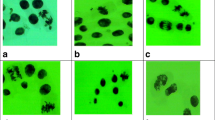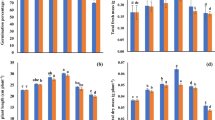Abstract
Almond is highly produced in the NE of Portugal, where late frosts during flowering, low precipitation, and high temperature in summer affect productivity and quality. Despite the use of late-flowering cultivars, plant biostimulants (PBs) and boron-based fertilizers can also be used to improve cell division, vegetative growth, photoassimilates rate, and nutritional status. PBs are widely used in some food crops, but the evaluation of their effects is still scarce. We treated three-year-old almond trees of cv. ‘Vairo,’ growing in a rainfed orchard in the NE of Portugal, with four individual treatments: two PBs (based on seaweed extract and free amino acids) and two boron-based fertilizers (applied on soil and leaves). Three monthly applications of seaweed extract (AN), free amino acids (AA), and boron ethanolamine (BE) were made. A single application of boron on the soil (BS) was made. Leaf samples were collected in treated and untreated (control) trees in cytogenetic and molecular analyses through the summer of 2019. The mitotic cell cycle analysis was performed to prepare mesophyll dividing cells stained with silver nitrate, and the molecular stability was assessed with five marker systems. This work aimed to extrapolate which individual treatment conferred higher mitotic cell cycle regularity and molecular stability. The cytogenetic and molecular data achieved in the cv. ‘Vairo,’ under the edaphoclimatic conditions studied, revealed that the individual treatments AA, BE, or BS induced higher leaf mitotic indexes, regular mitosis, and molecular stability, which might increase the photosynthetic area and production.



Similar content being viewed by others
Data Availability
All data generated or analysed during this study are included in this article and its supplementary information files.
Code Availability
Not applicable.
References
Al-Ashkar I, Alderfasi A, Romdhane WB, Seleiman MF, El-Said RA, Al-Doss A (2020) Morphological and genetic diversity within salt tolerance detection in eighteen wheat genotypes. Plants 9:287. doi: https://doi.org/10.3390/plants9030287
Alioto T, Alexiou KG, Bardil A (2020) Transposons played a major role in the diversification between the closely related almond and peach genomes: results from the almond genome sequence. Plant J 101:455–472
Berendsen RL, Pieterse C, Bakker P (2012) The rhizosphere microbiome and plant health. Trends Plant Sci 17(8):478–486
Bozari S, Aksakal O (2013) Application of random amplified polymorphic DNA (RAPD) to detect genotoxic effect of trifluralin on maize (Zea mays). Drug Chem Toxicol 36(2):163–169
Calvo P, Nelson L, Kloepper JW (2014) Agricultural uses of plant biostimulants. Plant Soil 383:3–41
Carrasco-Gil S, Hernandez-Apaolaza L, Lucena JJ (2018) Effect of several commercial seaweed extracts in the mitigation of iron chlorosis of tomato plants (Solanum lycopersicum L.). Plant Growth Regul 86:401–411
Carvalho A, Leal F, Matos M, Lima-Brito J (2018) Effects of heat stress in the leaf mitotic cell cycle and chromosomes of four wine-producing grapevine varieties. Protoplasma 255(6):1725–1740
Carvalho A, Matos M, Lima-Brito J, Guedes-Pinto H, Benito C (2005) DNA fingerprint of F1 interspecific hybrids from the Triticeae tribe using ISSRs. Euphytica 143:93–99
Carvalho A, Reis S, Pavia I, Lima-Brito J (2019) Influence of seed priming with Iron and/or Zinc in the nucleolar activity and protein content of bread wheat. Protoplasma 256:763–775
Castro C, Carvalho A, Gaivão I, Lima-Brito J (2021) Evaluation of copper-induced DNA damage in Vitis vinifera L. using Comet-FISH. Environ Sci Pollut Res 28(6):6600–6610
Colla G, Cardarelli M, Rouphael Y (2020) Plant biostimulants: new tool for enhancing agronomic performance and fruit quality of cucurbits. Acta Hortic 1294. ISHS 2020. doi:10.17660/ActaHortic.2020.1294.31 Proc VI International Symposium on Cucurbits. Eds.: P. Bleyaert and M.-C. Van Labeke
Correia S, Matos M, Ferreira V, Martins N, Gonçalves S, Romano A, Pinto-Carnide O (2014) Molecular instability induced by aluminum stress in Plantago species. Mutat Res 770:105–111
Doyle JJ, Doyle JL (1987) A rapid DNA isolation procedure for small quantities of fresh leaf tissue. Phytochem Bull 19:11–15
EU (2019) Regulation (EU) 2019/1009 of the European Parliament and of the Council of 5 June 2019 laying down rules on the making available on the market of EU fertilising products and amending Regulations (EC) No 1069/2009 and (EC) No 1107/2009 and repealing Regulation (EC) No 2003/2003. [http://data.europa.eu/eli/reg/2019/1009/oj] (Accessed 2021 Jan 10th)
Foster TM, Aranzana MJ (2018) Attention sports fans! The far-reaching contributions of bud sport mutants to horticulture and plant biology. Hortic Res 5:44
García-Santiago JC, Cavazos CJL, González-Fuentes JA et al (2021) Effects of fish-derived protein hydrolysate, animal-based organic fertilisers and irrigation method on the growth and quality of grape tomatoes. Biol Agric Hortic 37(2):107–124
Glosh M, Jana A, Sinha S, Jothiramajayam M, Nag A, Chakraborty A, Mukherjee A, Mukerjee A (2016) Effects of ZnO nanoparticles in plants: cytotoxixity, genotoxicity, deregulation of antioxidant defences, and cell-cycle arrest. Mutat Res Genet Toxicol Environ Mutagen 807:25–32
Gray DJ(2003) Seed development/ Artifitial seeds. Encyclopedia of Applied Plant Sciences. Elsevier. pp. 1305–1310. doi:https://doi.org/10.1016/B0-12-227050-9/00034-X
Gupta S, Doležal K, Kulkarni MG et al (2022) Role of non-microbial biostimulants in regulation of seed germination and seedling establishment. Plant Growth Regul 97:271–313
Klein P, Chauvey L, Kallerhoff J, Pinelli E, Morard M, Silvestre J (2021) A tool derived from the Vicia faba micronucleus assay, to assess genotoxicity, cytotoxicity or biostimulation of novel compounds used in agriculture. Agronomy 11:321. https://doi.org/10.3390/ agronomy11020321
Kumar A, Hirochika H (2001) Applications of retrotransposons as genetic tools in plant biology. Trends Plant Sci 6(3):127–134
Lima-Brito J, Carvalho A, Martín A, Heslop-Harrison JS, Guedes-Pinto H (2006) Morphological, yield, cytological and molecular characterisation of a bread wheat x tritordeum F1 hybrid. J Genet 85:123–131
Mondragón-Valero A, Malheiro R, Salazar DM, Pereira JA, Lopéz-Cortés I (2019) Changes produced by the application of biostimulants on almond rootstocks properties during the nursery process. AAB Bioflux 11(1):56–71
Mondragón-Valero A, Malheiro R, Salazar DM, Martínez-Tomé J, Pereira JA, López-Cortés I (2020) The development of the radicular and vegetative systems of almond trees with different rootstocks following the application of biostimulants. Span J Agric Res 18(4):e0904. https://doi.org/10.5424/sjar/2020184-14787
Nefic H, Musanovic J, Metovic A, Kurteshi K (2013) Chromosomal and nuclear alterations in root tip cells of Allium cepa L. induced by alprazolam. Med Arch 67(6):388–392
Pascoalino LA, Reis FS, Barros L et al (2021) Effect of plant biostimulants on nutritional and chemical profiles of almond and hazelnut. Appl Sci 11:7778. https://doi.org/10.3390/app11177778
Pekol S, Baloğlu MC, Altunoğlu YC (2016) Evaluation of genotoxic and cytotoxic effects of environmental stress in wheat species with different ploidy levels. Turk J Biol 40:580–588
Qi F, Zhang F (2020) Cell cycle regulation in the plant response to stress. Front Plant Sci 10:1765. doi: https://doi.org/10.3389/fpls.2019.01765
Queirós F(2020) Manual de boas práticas de fruticultura - Amendoeira, 5º Fascículo. Frutas Legumes e Flores em parceria com INIAV, I.P. (Estação Nacional de Fruticultura Vieira Natividade) e COTR, 13 p. [https://www.rederural.gov.pt/centro-de-recursos/send/2-agricultura-agroindustria/1868-manual-de-boas-praticas-de-fruticultura-amendoeira]
Rouphael Y, Colla G (2020) Editorial: Biostimulants in Agriculture. Front Plant Sci 11:40. doi: https://doi.org/10.3389/fpls.2020.00040
Saa S, Olivos-DelRio A, Castro S, Brown PH (2015) Foliar application of microbial and plant based biostimulants increases growth and potassium uptake in almond (Prunus dulcis [Mill.]. Front Plant Sci 6:87. doi: https://doi.org/10.3389/fpls.2015.00087. D.A. Webb
Santos CLV, Pourrut B, Ferreira de Oliveira JMP (2015) The use of comet assay in plant toxicology: recent advances. Front Genet 6:216. https://doi.org/10.3389/fgene.2015.00216
Silprasit K, Ngamniyom A, Kerksakul P, Thumajitsakul S (2016) Using morphology and genomic template stability (GTS) to track herbicide effect on some submersed aquatic plants. Appl Environ Res 38:75–85
Silva TS, Silva APS, Santos AA et al (2020) Cytotoxicity, genotoxicity, and toxicity of plant biostimulants produced in Brazil: subsidies for determining environmental risk to non-target species. Water Air Soil Pollut 231:233
Thomas B (2017) Leaf development. In: Thomas B, Murray BG, Murphy DJ (eds) Encyclopedia of Applied Plant Sciences, 2nd edn. Academic Press, Elsevier, Oxford, pp 191–197
Torres E, Paredes L, Miarnau X, Alonso D(2015) Basfoliar® Frost Protect prevent peach and almond flowers from frost damage. In: Abstracts book for oral and poster presentations, The 2nd World Congress on the use of biostimulants in agriculture, 16th to 19th November, 2015, Florence, Italy, p. 202
Vargas FJ, Romero M, Clavé J, Vergés J, Santos J, Batlle I (2008) Vairo’, ‘Marinada’, ‘Constanti’, and ‘Tarraco’ almonds. HortScience 43:535–537
Vargas FJ, Romero MA, Clavé J, Batlle I, Miarnau X, Alegre S (2011) Important traits in IRTA’s new almond cultivars. Acta Hortic 912:359–365
Yigider E, Taspinar MS, Aydin M, Agar G (2020) Cobalt-induced retrotransposon polymorphism and humic acid protection on maize genome. Biol Futur 71:123–130
Yigider E, Taspinar MS, Sigmaz B, Aydin M, Agar G (2016) Humic acids protective activity against manganese induced LTR (long terminal repeat) retrotransposon polymorphism and genomic instability effects in Zea mays. Plant Gene 6:13–17
Acknowledgements
The author AC thanks the Foundation for Science and Technology (FCT, Portugal) and the University of Tras-os-Montes and Alto Douro (UTAD) for her contract as a researcher under D.L. no. 57/2016 of 29 August and Law no. 57/2017 of 19 July.
Funding
This research was funded by national funds provided by the FCT/MCTES (“Fundação para a Ciência e a Tecnologia/ Ministério da Ciência, Tecnologia e Ensino Superior”) to the research units CIMO (UIDB/00690/2020) and CITAB (UIDB/04033/2020). The research was integrated in the activities of the Operational Group “EGIS: Estratégias para uma gestão integrada do solo e da água em espécies produtoras de frutos secos”, funded by PT2020 and EAFRD (European Agricultural Fund for Rural Development).
Author information
Authors and Affiliations
Contributions
Ana Esteves and Ana Carvalho realized the cytogenetic and molecular analyses. Ana Esteves, João Roque, Manuel A. Rodrigues and Carlos M. Correia made the fieldwork, samples collection and/or maceration. Ana Carvalho and José Lima-Brito were responsible for the conception of the study and analyses of the cytogenomic results. All authors were involved in the writing and revision of the manuscript and approved the submission of the final version.
Corresponding author
Ethics declarations
Conflict of interest/ Competing interests
The authors declare that there are no conflicts of interest.
Ethics approval
Not applicable.
Consent to participate
Not applicable.
Consent for publication
Not applicable.
Additional information
Communicated by Vijay Pratap Singh.
Publisher’s Note
Springer Nature remains neutral with regard to jurisdictional claims in published maps and institutional affiliations.
Electronic supplementary material
Below is the link to the electronic supplementary material.
Rights and permissions
About this article
Cite this article
Esteves, A., Carvalho, A., Roque, J. et al. Cytogenetic and molecular characterization of almond trees treated with plant biostimulants or boron-based fertilizers. Plant Growth Regul 98, 179–187 (2022). https://doi.org/10.1007/s10725-022-00845-6
Received:
Accepted:
Published:
Issue Date:
DOI: https://doi.org/10.1007/s10725-022-00845-6




